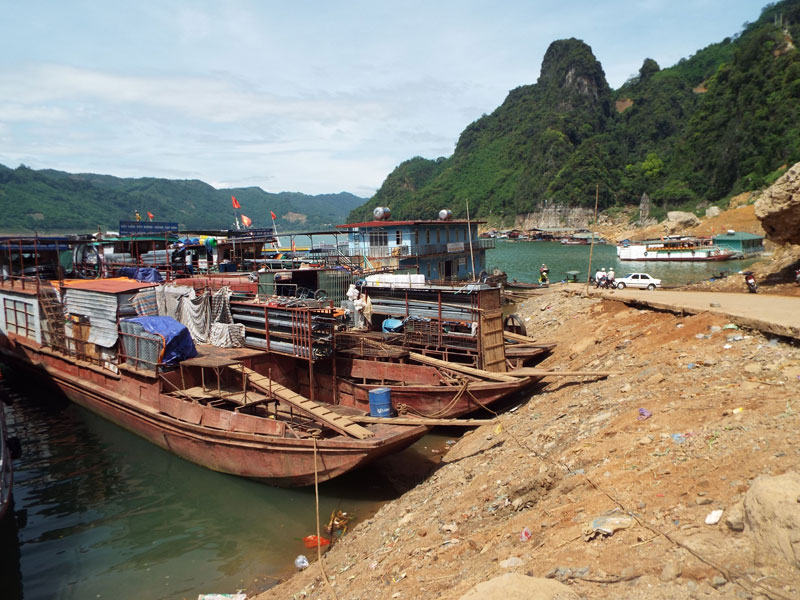
(HBO) – Bich Ha Port, located in the left bank of Hoa Binh Lake in Thai Thinh commune of Hoa Binh city, is one of the important facilities serving the transportation of goods from the city to communes bordering the lake and Son La province.
However,
the port’s infrastructure has degraded after years of being used. Without a
dock, tourists still have to move along natural paths, which is unsafe.
Meanwhile, boats carrying goods and tourists haven’t had their own areas to
operate at the port.

In the province’s port development plan until 2020,
Bich Ha Port will be upgraded to meet the requirements for the Hoa Binh Lake area
to become a national tourism site.
Problems of ports and wharves along the Da River
will be addressed soon when the provincial People’s Committee issued a plan on
the development of local ports until 2020. Bich Ha Port is set to be upgraded
to serve both goods and tourist transportation when Hoa Binh Lake becomes a national
tourism site.
Nguyen Ba Nhu, head of the transportation
division at the provincial Department of Transport, said the Prime Minister’s
approval of a plan on building the Hoa Binh Lake National Tourism Site is a big
favourable condition for Hoa Binh province to tap its tourism potential.
On May 31, 2017, the provincial People’s
Committee approved a development plan for inland ports in Hoa Binh until 2020.
Accordingly, some existing ports will be improved while three ports in the
downstream area of the Hoa Binh hydropower plant will be developed. Of which, Hoa
Binh Port in the right bank of the Da River will specialise in loading goods.
Another specialised port will be developed in the left bank of the Da River,
where a cement factory used to be located. The third port in Thinh Lang ward
will serve mixed purposes.
While Bich Ha Port will be upgraded to cater for
both goods and tourist transportation, Thung Nai Port will be expanded to serve
tourism. Some wharves are also expected to gain a facelift such as Binh Thanh
(Cao Phong district), and Bai Sang and Phuc San (Mai Chau district).
Provincial authorities are devising a plan to
balance resources for infrastructure investment so as to attract businesses to
developing tourism products for the future national tourism site of Hoa Binh
Lake./.
A diverse chain of eco-tourism and resort destinations concentrated in Hoa Binh city and the districts of Tan Lac, Da Bac, and Luong Son… Along with the launch of several key high-quality resort tourism projects, these developments have reshaped the landscape and enhanced the appeal of Hoa Binh as a travel destination.
Boasting diverse terrain, a mild climate, and rich natural resources, Cao Phong district is increasingly asserting its place on Vietnam’s tourism map, attracting both domestic and foreign visitors. The district is renowned for its stunning landscapes, majestic mountains, a crystal-clear hydropower lake, and the unique cultural identity of local ethnic groups.
With its pristine landscapes, unique cultural heritage of Muong ethnic minority, and an expanding range of visitor experiences, Tan Lac district of Hoa Binh has fast become a captivating destination for both domestic and international tourists.
Until now, Sung village in Cao Son commune, Da Bac district remains the only Dao ethnic community in Hoa Binh province to develop a community-based tourism model. Beyond its untouched natural landscapes, cultural identity serves as the cornerstone attraction for visitors.
Alongside the diverse cultural identities of the Kinh, Muong, Tay, Thai, Dao, and Mong ethnic people, Hoa Binh province is also renowned as the "capital" of the northwestern Vietnamese cuisine, offering unique and distinctive dishes. At festivals, during Lunar New Year (Tet), or on significant family or community occasions, special dishes are prepared, leaving a lasting impression on visitors.
A Phong Linh (Yellow Tabebuia) flower garden in Thang village, Thach Yen commune, Cao Phong district is currently in full bloom, drawing a large number of visitors.



